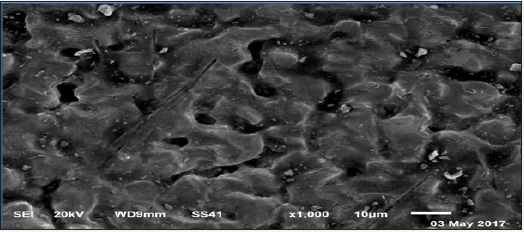Influence of Titanium Oxide on Structure, Corrosion and Soldering Properties of Sn82Bi15Zn3 Alloy by Abu Bakr El-Bediwi* in Research & Development in Material Science_ Materials Science and Technology

Abstract
Our
work study the effect of titanium oxide on structure, soldering properties such
as melting temperature, wetting process and corrosion behavior of Sn82Bi15Zn3
alloy. Microstructure of Sn82Bi15Zn3 alloy
changed after adding different ratio from titanium oxide. Lattice microstrain
of Sn82Bi15Zn3 alloy varied (increased) after
adding titanium oxide. Melting temperature of Sn82Bi15Zn3
alloy varied after adding Ti2O. Sn81.4Bi15Zn3(Ti2O)0.6
alloy has low melting temperature. The contact angle Sn82Bi15Zn3
alloy decreased after adding different ratio from titanium oxide. Corrosion
resistance of Sn82Bi15Zn3 alloy varied
(increased) after adding Ti2O. From our results, soldering
properties (melting temperature and contact angle) and corrosion resistance of
Sn82Bi15Zn3 alloy improved after adding Ti2O.
Introduction
Soldering
is a low temperature
metallurgical joining process. In electronics applications low temperature and
reversibility are especially important because of the materials involved and
the necessity for reworking and making engineering changes. Solder joining is a
wetting process followed by a chemical reaction. Wettability is a function of
the materials to be joined, with Cu, Ni, Au, and Pd, as well as alloys rich in
one or more of these metals, being particularly amenable to soldering. The
chemical reaction following wetting is between the molten solder and the
joining metallurgy to form an intermetallic phase region at the interface.
Microstructure, wettability and physical properties of Sn96-xZn4Bix alloys are
reported by El-Bediwi et al. [1]. The melting temperature of Sn96Zn4 alloy
decreased after adding bismuth. But contact angle of Sn96Zn4 alloy varied after
adding bismuth. Adding silver caused a significant increase in bismuth-tin-zinc
alloy strengthens with a little decreased in melting temperature [2]. El-Bediwi
et al. [2] reported that, there is a significant decrease in melting
temperature of bismuth-tin-zinc
alloy with a very little increase in strengthens after adding indium.
Microstructure, thermal parameters, wettability and electrochemical corrosion
process of Bi30Sn50Sb10A15Zn3Cu2, Bi25Sn61Sb5Zn4Al3Ag2, and
Bi20Sn60Sb7A15Zn3Cd3Cu2, alloys have been studied [3]. Microstructure,
wettability behavior, corrosion parameters, thermal properties of quaternary
bismuth- tin based alloy have been investigated using different experimental
techniques and the results show that, some properties of Bi60Sn40 alloy
improved after adding Sb-Zn or Sb-Ag elements [4]. Tin- zinc eutectic alloy has
been considered as a candidate for lead free solder materials because of its
low melting point, excellent mechanical properties and low cost [5-7]. Mostly
solders are based on Sn-containing binary and ternary alloys. Several elements
have been selected as alloying elements such as Zn, Bi, Cu, Ag, Sb and so on
[8-10]. Specific researchers [11-15] reported that, tin- zinc eutectic solder
alloy is poor wettability, reliability, strength, easy oxidation and microvoid
formation. To avoid these disadvantages or improve the properties of it, they
added minor amount of Bi, Cu, In, Ag, Al, Ga, Sb, Cr, Ni, Ge elements to develop
ternary and even quaternary Pb free alloys. The aim of our work was to study
the effect of titanium dioxide on microstructure, soldering properties and
corrosion of tin bismuthzinc alloy
https://crimsonpublishers.com/rdms/fulltext/RDMS.000630.php
Crimson
Publishers: https://crimsonpublishers.com/
For more articles in Materials Science and Technology,
Please click on below link: https://crimsonpublishers.com/rdms/


No comments:
Post a Comment